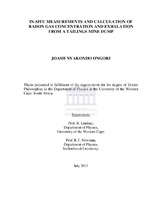| dc.description.abstract | In Africa as well as in the world, South Africa plays an important role in the mining industry which dates back almost 120 years. Mining activities in South Africa mainly take place in Gauteng Province. Every year millions of tons of rocks are taken from underground, milled and processed to extract gold. Uranium is one of the minerals which is mined as a by-product of gold. The uranium bearing tailings are then placed on large dumps which are usually one or more kilometres in diameter in the environment. There are approximately 250 gold mine tailings dumps covering a total area of about 7000 ha. These gold mine tailings dumps contain considerable amounts of radium (226Ra) and have therefore been identified as large sources of radon (222Rn). Radon release from these tailings dumps pose health concerns for the surrounding communities. This study reports on the 222Rn soil-gas concentrations and exhalations measurements which were conducted at a non-operational mine dump (Kloof) which belongs to Carletonville Gold Field, Witwatersrand, South Africa. Radon soil-gas concentrations were measured using a continuous radon monitor (the Durridge RAD7). The radon soil gas concentration levels were measured at depths starting from 30 cm below ground/air interface up to 110 cm at intervals of 20 cm. These radon soil-gas measurements were performed at five different spots on the mine dump. The concentrations recorded ranged from to kBq.m-3. Furthermore, thirty four soil samples were taken from these spots for laboratory-based measurement. The soil samples were collected in the depth range 0-30 cm and measured using the low-background Hyper Pure Germanium (HPGe) -ray detector available at the Environmental Radioactivity Laboratory (ERL), iThemba LABS, Western Cape Province. The weighted average activity concentrations in the soils samples were Bq.kg-1, Bq.kg-1 and Bq.kg-1 for 238U, 40K and 232Th, respectively. 1 26 23 472 7 308 5 2551 18
The activity concentration of 40K and the decay series of 238U and 232Th for the top 30 cm of the accessible parts of the mine dump were measured using the MEDUSA (Multi-Element Detector for Underwater Sediment Activity) -ray detection system which was mounted on the front of a 44 vehicle, 0.6 m off the ground. The spectra acquired by the MEDUSA system were analysed and the activity concentrations were extracted using the Full Spectrum Analysis approach. The average activity concentrations obtained were 25975 Bq.kg-1 for 40K, 30940 Bq.kg-1 for 238U series and 185Bq.kg-1 for 232Th series for 2002 survey while 26075 Bq.kg-1 for 40K, 31040 Bq.kg-1 for 238U series and 20 5 Bq.kg-1 for 232Th series were recorded for 2010 survey. Moreover, a novel technique by means of the MEDUSA -ray detection system was utilised to map radon exhalation from the Kloof mine dump. In this technique the 214Bi concentration in the top 30 cm of the dump, which is used as a proxy for the 238U or 226Ra concentration, is measured even though there is not secular equilibrium between the radium and bismuth because radon has escaped. The actual activity concentrations of 40K and 226Ra are obtained from soil samples which were collected, sealed and measured in the laboratory settings after attaining secular equilibrium since radon gas does not escape. By comparing the ratios of the activity concentrations of the 214Bi obtained in the field using the MEDUSA -ray detector system to the activity concentrations of the 214Bi obtained in the laboratory using the HPGe -ray detector system yields a reasonable radon exhalation for a particular location in the mine dump. In this case it is assumed that the 40K and 232Th series activity concentrations are not or hardly affected by radon exhalation. By applying this new technique an average normalised radon flux of 0.120.02 and 0.120.02 Bq.m-2.s-1 were obtained for 2002 and 2010 surveys, respectively. The electrets and the IAEA standard formula were also utilised to calculated radon fluxes yielding 0.060.02 and 0.120.02 Bq.m-2.s-1 respectively. | en_US |

